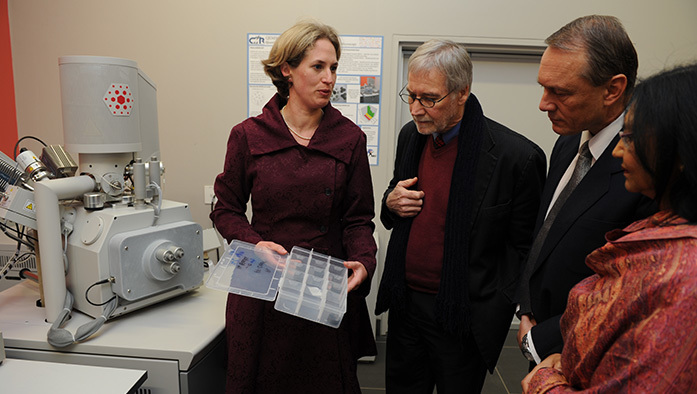New machine a boon to minerals research
25 June 2014 | Story by Newsroom
Extracting valuable minerals from ore becomes increasingly difficult as the quality of ore steadily declines. Enter QEMSCAN (Quantitative Evaluation of Minerals by Scanning Electron Microscopy), a new acquisition by UCT's Centre for Minerals Research, that is able to identify valuable minerals in ore of such low quality that it was previously thought of as sub-economic.
Largely subsidised by the National Research Foundation (NRF), the R14-million QEMSCAN machine provides detailed quantitative analysis of minerals, rocks, soils and man-made products, far more quickly than was previously possible. The key is a high-energy accelerating electron beam that scans the surface of an object and produces a colour-coded picture of the minerals it comprises.
"You can see QEMSCAN as a potential tool to unlock process mineralogy of complex ores," says Dr Megan Becker, who heads process mineralogy at UCT's Centre for Mineral Research (CMR).
Speaking at the instrument's official launch on 19 June, Becker said that the new QEMSCAN machine will be vital to maintaining the highest quality of research and industrial performance. It replaces the 14-year old LEO QEMSCAN that Anglo American Platinum donated to CMR in 2010, and which helped establish the centre's mineralogical analysis capability. This older machine was traded in, allowing CMR to purchase the new version at roughly half the price.
Innovative technology to unlock value of rocks
As high-quality ore stocks become depleted, mining companies are forced to revisit those ores that had relatively small concentrations of the minerals they desired. Before QEMSCAN technology, says Becker, analysing these samples was a laborious matter of poring through microscopes and recording data manually.
"We know that these easy-to-process ores are running out. The mining industry will be forced to overcome a mineralogical barrier using innovative technology to unlock the value of rocks that are currently considered sub-economic.
"In order to do so, we need to remain focused on both the technology and the people, and the successful use of process mineralogy requires the appropriate training of future generations both to acquire and interpret the results that are obtained through ever-increasingly sophisticated technology as well as effective communication between the multi-disciplinary teams comprising engineers, scientists, business people and society."
Sharing technology
The new QEMSCAN will be available to industry and other institutions in the region, including the University of the Western Cape, the Cape Peninsula University of Technology and the University of Stellenbosch. Applications may include these related to mineral processing, minerals beneficiation, metallurgy, economic geology, environmental science, oil and gas, archaeology, environmental science, soil science and viticulture.
Legal expert and Deputy Vice-Chancellor for Research Professor Danie Visser related how the QEMSCAN was even useful in his field. A murder case in the Republic of Northern Ireland in 2005 needed detailed forensic analysis, and there was one instrument that the state turned to.
"To prove who did it, they used a QEMSCAN to determine that the minerals in the soil in a particular house where they knew one of the accused had been, and the soil that they scraped from the car they also knew had been used, was probably the same," said Visser.
Professor Francis Petersen, dean of the Faculty of Engineering & the Built Environment, congratulated the CMR on its acquisition of "this fantastic piece of equipment".
"One often says that when you have a cutting-edge piece of equipment, you can also do cutting-edge research," said Petersen. "I think that is exactly what this piece of equipment will do for us."
Moreover, said Petersen, the QEMSCAN would build human capacity by aiding CMR researchers while also building relationships with other institutions, paving the way to new collaborations.
Professor Dave Deglon, director of the CMR, thanked those involved in procuring the "expensive, very beautiful, very useful" machine, particularly the National Research Foundation, Anglo American Platinum and the CMR itself, who raised part of the funding.
Story by Yusuf Omar. Image by Michael Hammond.
 This work is licensed under a Creative Commons Attribution-NoDerivatives 4.0 International License.
This work is licensed under a Creative Commons Attribution-NoDerivatives 4.0 International License.
Please view the republishing articles page for more information.










